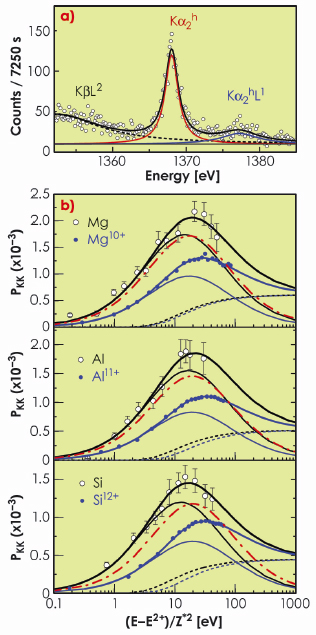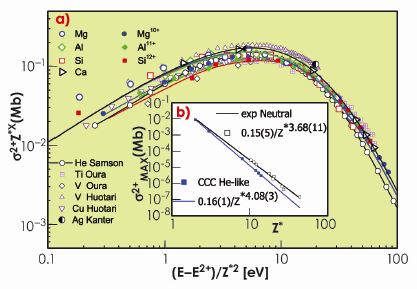- Home
- Users & Science
- Scientific Documentation
- ESRF Highlights
- ESRF Highlights 2009
- Electronic structure and magnetism
- Hollow K-shell atoms created via single-photon double ionisation
Hollow K-shell atoms created via single-photon double ionisation
Electron correlation effects lie at the heart of our understanding of atomic structure. Yet their quantitative description, in particular in many-body systems, is far from complete. To shed new light on atomic electron correlation effects, the single-photon double K-shell photoionisation (DPI) was investigated. In this weak process, a single photon removes the two innermost electrons and produces a “so-called” hollow K-shell atom, i.e. an atom with an empty inner-most shell and outer shells occupied. Because of the single-particle nature of the photon-electron interaction, the K-shell double photoionisation is driven by many-electron interactions.
The photon energy dependence of the K-shell DPI of Mg, Al and Si was investigated. This is the first study of these elements and also for such a wide range of photon energies from the DPI threshold up and beyond the maximum of the double-to-single photoionisation ratios PKK. The experiments were carried out at the beamlines ID21 and ID26 using the Fribourg von Hamos Bragg-type curved crystal X-ray spectrometer [1]. The experimental method was based on high-resolution measurements of X-ray spectra following the radiative decay of the K-shell double vacancy states (see Figure 97a). The PKK were deduced from the relative intensities of the resolved hypersatellite Kah (1s-2 ![]() 1s-12p-1) to the diagram K
1s-12p-1) to the diagram K![]() (1s-1
(1s-1 ![]() 2p-1) X-ray transitions. DPI cross sections were determined by employing the relation
2p-1) X-ray transitions. DPI cross sections were determined by employing the relation ![]() 2+ = PKK
2+ = PKK![]() +, where
+, where ![]() + stands for the single K-shell photoionisation cross section.
+ stands for the single K-shell photoionisation cross section.
The double-to-single K-shell photoionisation ratios for neutral Mg, Al and Si versus the scaled excess energy (E-E2+)/Z*2, where E2+ stands for the DPI threshold and Z* is the effective nuclear charge, are shown in Figure 97b. The effective charge was derived from the binding energy of the remaining K-shell electron E+ using the hydrogenic formula E+ = Z*2 Ry, where Ry = 13.6 eV. In order to evince the relative importance of the initial- and final-state electron-electron interaction to the K-shell DPI, we have fitted the PKK adopting an approach based on an incoherent summation of the shake-off (SO) and knock-out (KO) terms. Shake-off corresponds to a sudden ejection of the photoelectron following single-photon absorption and a subsequent change of the atomic potential, which may lead to a removal of the remaining 1s electron to the continuum. In case of knock-out, the outgoing photoelectron knocks out the second 1s electron in an (e,2e)-like electron impact half collision. Furthermore, we have raised the question as to the role played by outer-shell electrons in the K-shell DPI. To this end, the PKK for neutral atoms were compared to convergent close-coupling (CCC) calculations [2] for He-like ions Mg10+, Al11+ and Si12+. The KO terms of He-like ions scaled by Z4/Z*4 were found to be close to the ones for neutral atoms. Our results suggest that KO dominates near threshold and at intermediate photon energies, and that the electron scattering contribution is more important for neutral atoms than in two-electron systems.
 |
|
Fig. 97: a) K-hypersatellite X-ray emission spectrum of Mg. b) Double-to-single K-shell photoionisation ratios for neutral atoms (open circles) compared to the CCC calculations for He-like ions (closed circles) as a function of the scaled excess energy. Solid thick lines - best fits, dashed lines - SO, thin solid lines - KO, and dot-dashed lines - KO terms of He-like ions scaled by Z4/Z*4. |
It is established that for two-electron ions, the DPI cross sections scale as 1/Z4. With this perspective, we have examined whether it is the case for neutral atoms. Indeed, the DPI cross sections were found to scale, but with a weaker exponent 1/Z*3.68. Furthermore, the scaled ![]() 2+ for neutral atoms and for the He isoelectronic series were found to collapse onto a single curve (see Figure 98).
2+ for neutral atoms and for the He isoelectronic series were found to collapse onto a single curve (see Figure 98).
 |
|
Fig. 98: a) Scaled experimental DPI cross sections for Mg, Al and Si compared to the scaled CCC calculations for He-ions and experimental data for higher Z elements versus the scaled excess energy. b) Power-law fits to the maximum values of |
In conclusion, we investigated the double ionisation of the two innermost atomic electrons upon single-photon absorption in neutral atoms and the corresponding simple systems, two-electron ions. An empirical model to separate the knock-out and shake-off mechanisms of the K-shell DPI was proposed. The results suggest that the post-photoabsorption electron correlation effects on K-shell DPI of neutral atoms are different in comparison with corresponding two-electron systems. A universal scaling behaviour of the DPI cross sections with the effective nuclear charge for neutral atoms in the range 2 ![]() Z
Z ![]() 47 was established.
47 was established.
References
[1] J. Hoszowska, J.-Cl. Dousse, J. Kern and Ch. Rhême, Nuclear Instrum. Methods Phys. Res., A 376, 129-137 (1996).
[2] A. Kheifets and I. Bray, Phys. Rev. A 58, 4501-4511 (1998).
Principal publication and authors
J. Hoszowska (a), A. Kheifets (b), J.-Cl. Dousse (a), M. Berset (a), I. Bray (c), W. Cao (a), K. Fennane (a), Y. Kayser (a), M. Kavčič (d), J. Szlachetko (a,e) and M. Szlachetko (a), Phys. Rev. Lett. 102, 073006 (2009).
(a) Department of Physics, University of Fribourg (Switzerland)
(b) Research School of Physical Sciences, Australian National University, Canberra (Australia)
(c) ARC Centre for Matter-Antimatter Studies, Curtin University, Perth (Australia)
(d) J. Stefan Institute, Ljubljana (Slovenia)
(e) ESRF



